Liquid Crystal Compound And Liquid Crystal Composition
YUN; GUOLIANG ; et al.
U.S. patent application number 15/990302 was filed with the patent office on 2019-02-21 for liquid crystal compound and liquid crystal composition. The applicant listed for this patent is SHIJIAZHUANG CHENGZHI YONGHUA DISPLAY MATERIAL CO. LTD.. Invention is credited to JIANMING CHENG, ZHE SHAO, KE-LUN SHU, GUOLIANG YUN, LIMEI ZHANG, XING ZHANG.
| Application Number | 20190055471 15/990302 |
| Document ID | / |
| Family ID | 65360328 |
| Filed Date | 2019-02-21 |



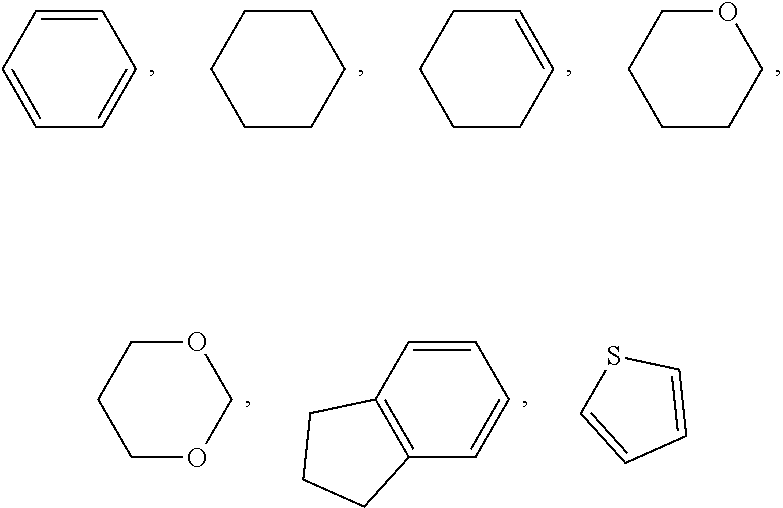

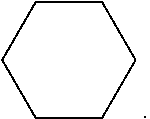


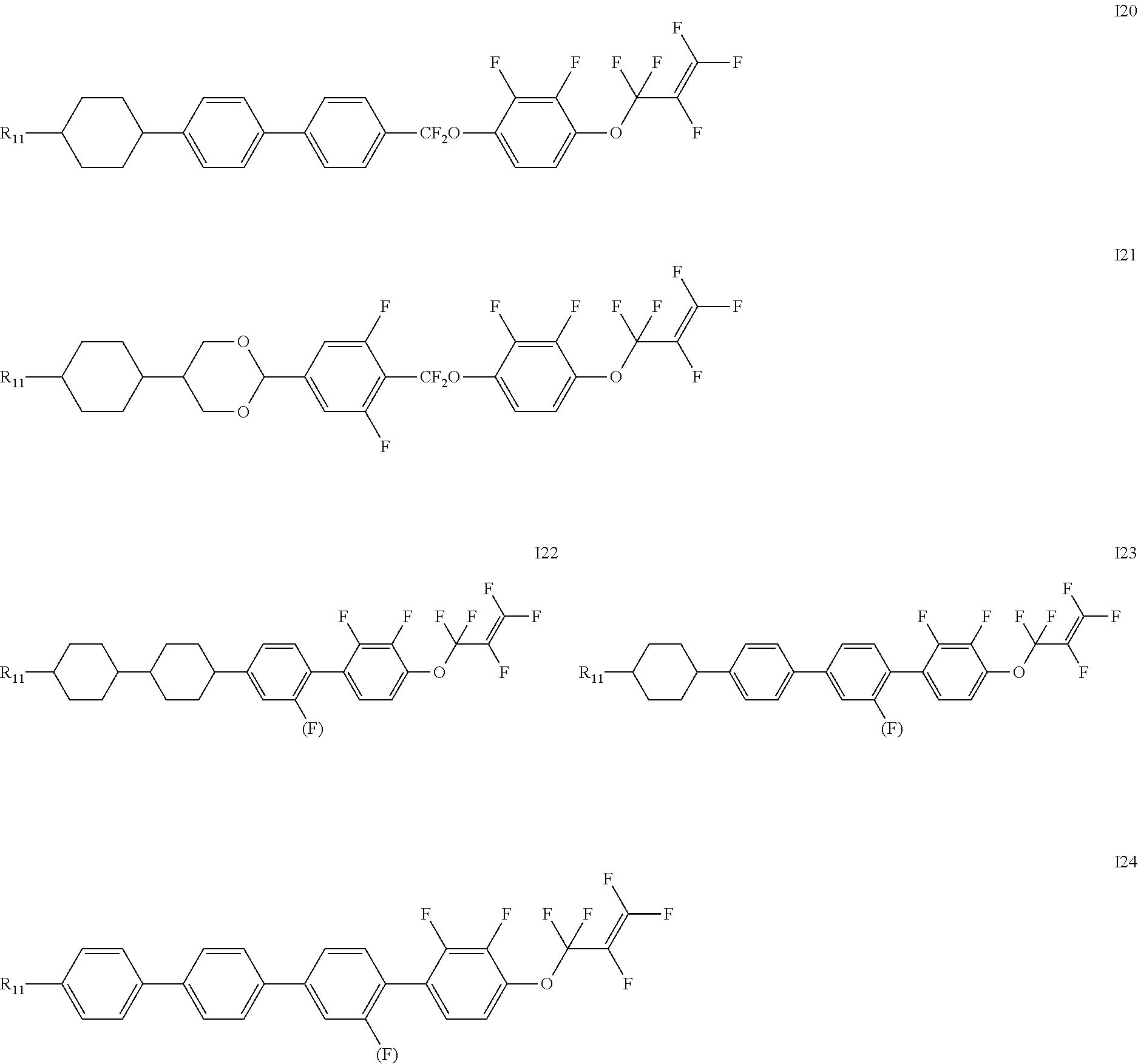

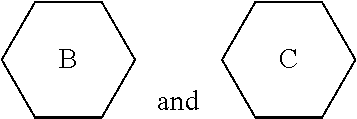

View All Diagrams
| United States Patent Application | 20190055471 |
| Kind Code | A1 |
| YUN; GUOLIANG ; et al. | February 21, 2019 |
LIQUID CRYSTAL COMPOUND AND LIQUID CRYSTAL COMPOSITION
Abstract
Provided is a liquid crystal compound represented by formula I, ##STR00001## the compound having a positive dielectric anisotropy, a great elastic constant and a good solubility. Further provided is a liquid crystal composition comprising the liquid crystal compound represented by formula I, the liquid crystal composition having a good stability against light and heat, a lower viscosity, a wider refractive index that may be achieved by the adjustment of the monomer ratio, and a higher clearing point (a very wide service temperature range), and in particular, the liquid crystal composition has a higher light transmittance, thus allowing a display device to have a higher brightness or an energy saving effect.
| Inventors: | YUN; GUOLIANG; (Shijiazhuang City, CN) ; SHU; KE-LUN; (Shijiazhuang City, CN) ; SHAO; ZHE; (Shijiazhuang City, CN) ; ZHANG; XING; (Shijiazhuang City, CN) ; CHENG; JIANMING; (Shijiazhuang City, CN) ; ZHANG; LIMEI; (Shijiazhuang City, CN) | ||||||||||
| Applicant: |
|
||||||||||
|---|---|---|---|---|---|---|---|---|---|---|---|
| Family ID: | 65360328 | ||||||||||
| Appl. No.: | 15/990302 | ||||||||||
| Filed: | May 25, 2018 |
| Current U.S. Class: | 1/1 |
| Current CPC Class: | C09K 2019/3025 20130101; C09K 19/3066 20130101; C09K 2019/3027 20130101; C09K 2019/124 20130101; C09K 2019/3016 20130101; C09K 2019/0466 20130101; C07C 43/225 20130101; C09K 2019/0444 20130101; C09K 2019/3009 20130101; C09K 2019/3019 20130101; C09K 2019/122 20130101; C09K 19/20 20130101; C09K 2019/3422 20130101; C09K 2019/123 20130101 |
| International Class: | C09K 19/20 20060101 C09K019/20; C07C 43/225 20060101 C07C043/225 |
Foreign Application Data
| Date | Code | Application Number |
|---|---|---|
| Aug 16, 2017 | CN | 201710704668.8 |
Claims
1. A liquid crystal compound represented by formula I, ##STR00044## wherein R.sub.1 represents an alkyl group having a carbon atom number of 1-10, a fluoro-substituted alkyl group having a carbon atom number of 1-10, an alkoxy group having a carbon atom number of 1-10, a fluoro-substituted alkoxy group having a carbon atom number of 1-10, an alkenyl group having a carbon atom number of 2-10, a fluoro-substituted alkenyl group having a carbon atom number of 2-10, an alkenoxy group having a carbon atom number of 3-8 or a fluoro-substituted alkenoxy group having a carbon atom number of 3-8, and any one or more non-connected CH.sub.2 in the groups represented by R.sub.1 may be substituted with cyclopentyl, cyclobutyl, cyclopropyl or --O--; each ##STR00045## independently represents ##STR00046## or fluorobenzene; n represents 1, 2, 3 or 4; and Z.sub.0 represents CF.sub.2O, CH.sub.2O, COO or a single bond.
2. The liquid crystal compound according to claim 1, wherein represents 2 or 3, not every ##STR00047## represents ##STR00048##
3. The liquid crystal compound according to claim 1, wherein the liquid crystal compound represented by formula I is a compound represented by formulas I1 to I14; ##STR00049## ##STR00050## ##STR00051## wherein each R.sub.11 independently represents an alkyl group having a carbon atom number of 1-6, cyclopentyl or cyclopropylmethyl; and each (F) independently represents F or H.
4. A liquid crystal composition, wherein said liquid crystal composition comprises one or more compounds represented by formula I of claim 1 and one or more compounds represented by formula II ##STR00052## wherein R.sub.2 and R.sub.3 each independently represent an alkyl group having a carbon atom number of 1-10, an alkenyl group having a carbon atom number of 2-10, an alkoxy group having a carbon atom number of 1-10, and any one or more non-connected CH.sub.2 in groups R.sub.2 and R.sub.3 may be substituted with cyclopentyl, cyclobutyl, cyclopropyl, or --O--; ##STR00053## each independently represent ##STR00054## and m represents 1 or 2.
5. The liquid crystal composition according to claim 4, wherein said compound represented by formula II is a compound represented by formulas II1 to II17 ##STR00055## ##STR00056## wherein R.sub.2 and R.sub.3 each independently represents an alkyl group having a carbon atom number of 1-10, an alkenyl group having a carbon atom number of 2-10, an alkoxy group having a carbon atom number of 1-10, and any one or more non-connected CH.sub.2 in groups R.sub.2 and R.sub.3 may be substituted with cyclopentyl, cyclobutyl, cyclopropyl, or --O--.
6. The liquid crystal composition according to claim 4, wherein in said liquid crystal composition, the total content in mass percentage of the compounds represented by formula I is 1-40%, and the total content in mass percentage of the compounds represented by formula II is 5-65%.
7. The liquid crystal composition according to claim 4, wherein said liquid crystal composition further comprises one or more compounds represented by formula III ##STR00057## wherein R.sub.4 represents an alkyl group having a carbon atom number of 1-10, a fluoro-substituted alkyl group having a carbon atom number of 1-10, an alkoxy group having a carbon atom number of 1-10, a fluoro-substituted alkoxy group having a carbon atom number of 1-10, an alkenyl group having a carbon atom number of 2-10, a fluoro-substituted alkenyl group having a carbon atom number of 2-10, an alkenoxy group having a carbon atom number of 3-8 or an fluoro-substituted alkenoxy group having a carbon atom number of 3-8; and any one or more CH.sub.2 in group R.sub.4 may be substituted with cyclopentyl, cyclobutyl or cyclopropyl; ##STR00058## each independently represents: ##STR00059## p represents 1, 2 or 3; Z.sub.1 and Z.sub.2 each independently represent a single bond, --CF.sub.2O--, --CH.sub.2CH.sub.2--, or --CH.sub.2O--; and Y.sub.2 represents F, a fluoro-substituted alkyl group having a carbon atom number of 1-5, a fluoro-substituted alkoxy group having a carbon atom number of 1-5, or an alkenyl group having a carbon atom number of 2-5.
8. The liquid crystal composition according to claim 7, wherein said one or more compounds represented by formula III are compounds of formulas III1 to III22 ##STR00060## ##STR00061## ##STR00062## wherein X.sub.1 and X.sub.2 each independently represent H or F; wherein each R.sub.4 independently represents an alkyl group having a carbon atom number of 1-10, a fluoro-substituted alkyl group having a carbon atom number of 1-10, an alkoxy group having a carbon atom number of 1-10, a fluoro-substituted alkoxy group having a carbon atom number of 1-10, an alkenyl group having a carbon atom number of 2-10, a fluoro-substituted alkenyl group having a carbon atom number of 2-10, an alkenoxy group having a carbon atom number of 3-8 or a fluoro-substituted alkenoxy group having a carbon atom number of 3-8, and any CH.sub.2 in group of R.sub.4 may be substituted with cyclopentyl, cyclobutyl or cyclopropyl; (F) represents H or F; and Y.sub.2 represents F, a fluoro-substituted alkyl group having a carbon atom number of 1-5, a fluoro-substituted alkoxy group having a carbon atom number of 1-5, or an alkenyl group having a carbon atom number of 2-5.
9. The liquid crystal composition according to claim 4, wherein said liquid crystal composition further comprises one or more compounds represented by formula IV ##STR00063## wherein R.sub.5 and R.sub.6 each independently represent an alkyl group having a carbon atom number of 1-10, a fluoro-substituted alkyl group having a carbon atom number of 1-10, an alkoxy group having a carbon atom number of 1-10, a fluoro-substituted alkoxy group having a carbon atom number of 1-10, an alkenyl group having a carbon atom number of 2-10, a fluoro-substituted alkenyl group having a carbon atom number of 2-10, an alkenoxy group having a carbon atom number of 3-8 or a fluoro-substituted alkenoxy group having a carbon atom number of 3-8, and any CH.sub.2 in groups R.sub.5 and R.sub.6 may be substituted with cyclopentyl, cyclobutyl or cyclopropyl; Z.sub.3 and Z.sub.4 each independently represent a single bond, --CH.sub.2CH.sub.2-- or --CH.sub.2O--; ##STR00064## each independently represent ##STR00065## h represents 1, 2 or 3; and i represents 0 or 1.
10. The liquid crystal composition according to claim 9, wherein the compound represented by formula IV is a compound represented by formulas IV1 to IV11 ##STR00066## ##STR00067## wherein R.sub.5 and R.sub.6 each independently represent an alkyl group having a carbon atom number of 1-10, a fluoro-substituted alkyl group having a carbon atom number of 1-10, an alkoxy group having a carbon atom number of 1-10, a fluoro-substituted alkoxy group having a carbon atom number of 1-10, an alkenyl group having a carbon atom number of 2-10, a fluoro-substituted alkenyl group having a carbon atom number of 2-10, an alkenoxy group having a carbon atom number of 3-8 or a fluoro-substituted alkenoxy group having a carbon atom number of 3-8, and any CH.sub.2 in groups R.sub.5 and R.sub.6 may be substituted with cyclopentyl, cyclobutyl or cyclopropyl.
11. A liquid crystal display element or liquid crystal display comprising the liquid crystal compound of claim 1, wherein said liquid crystal display element or liquid crystal display is an active matrix display element or display or a passive matrix display element or display.
Description
TECHNICAL FIELD
[0001] The present invention belongs to the technical field of liquid crystal materials, and more particularly relates to a highly vertical dielectric positive liquid crystal compound, a liquid crystal composition, and a liquid crystal display device containing such a liquid crystal.
BACKGROUND ART
[0002] At present, the expansion of application range of liquid crystal compounds becomes larger and larger, and the liquid crystal compounds can be used in various types of displays, electro-optical devices, sensors, etc. There are a great variety of liquid crystal compounds used in the above-mentioned display field, wherein nematic liquid crystals are used most extensively. Nematic liquid crystals have been used in passive TN and STN matrix displays and systems having a TFT active matrix.
[0003] With regard to the application field of thin film transistor techniques (TFT-LCD), although the market in recent years has become very huge, and the techniques also become gradually mature, requirements of display techniques are increasing continuously, especially in terms of achieving a quick response, reducing the drive voltage for reducing power consumption, etc. Liquid crystal materials, as one of the important optoelectronic materials for liquid crystal displays, play an important role in improving the performance of a liquid crystal display.
[0004] As liquid crystal materials, they need to have good chemical and thermal stabilities and stabilities to electric fields and electromagnetic radiations. Moreover, as liquid crystal materials used for thin film transistor techniques (TFT-LCD), they not only need to have the stabilities as mentioned above, but also should have properties, such as a broader nematic phase temperature range, a suitable birefringence anisotropy, a very high electrical resistivity, a good ultraviolet resistant property, a high charge retention rate, a low vapour pressure, etc.
[0005] As for the application of dynamic picture displays, elimination of ghosting and trailing of display pictures, the liquid crystal is required to have a very fast response speed, and therefore the liquid crystal is required to have a lower rotary viscosity .gamma..sub.1; in addition, for portable devices, the driving voltage of liquid crystal is desired to be as low as possible, in order to reduce the equipment energy consumption, and for displays for use in televisions, the requirements of drive voltage of the liquid crystals are not as low as that.
[0006] The viscosity, in particular rotary viscosity .gamma..sub.1, of a liquid crystal compound directly affects the response time after the liquid crystal is energized, and both the rise time (t.sub.on) and fall time (t.sub.off) are proportional to the rotary viscosity .gamma..sub.1 of the liquid crystal; moreover, since the rise time (t.sub.on) is related to a liquid crystal cell and the drive voltage, it can be adjusted by means of increasing the drive voltage and reducing the thickness of the liquid crystal cell; while the fall time (t.sub.off) is irrelevant to the drive voltage, but is mainly related to the elastic constant of the liquid crystal and the thickness of the liquid crystal cell, and thinning of cell thickness can result in a decrease in fall time (t.sub.off); moreover, in different display modes, the movement manners of liquid crystal molecules are different, and the three modes TN, IPS and VA are inversely proportional to the mean elastic constant K, twist elastic constant and bend elastic constant, respectively.
[0007] After the introduction of a difluoromethyleneoxy linking group (--CF.sub.2O--) into the liquid crystal molecule, the rotary viscosity .gamma..sub.1 of the liquid crystal decreases. In addition, due to the contribution of the dipole moment of the difluoromethyleneoxy bridge (--CF.sub.2O--), the dipole moment of the end group fluorine atom also increases to some extent, such that the dielectric anisotropy .DELTA..epsilon. of the liquid crystal molecule increases. Some liquid crystal compounds having a difluoromethyleneoxy linking group (--CF.sub.2O--) having different substituents have been disclosed (CN 201210083535.0, CN 201410764634.4, etc.). However, the introduction of the --CF.sub.2O-- group can significantly reduce the clearing point of the liquid crystal.
[0008] According to the continuum theory of liquid crystal, a variety of different liquid crystals deformed under the action of an external force (an electric field, a magnetic field) can "rebound" back to the original shapes by intermolecular interactions; likewise, liquid crystals also form a "viscosity" due to the intermolecular force. Small changes of liquid crystal molecules may result in obvious changes in the conventional parameter performance of the liquid crystal, wherein for some of these changes, there is a certain rule, while for some changes, it is difficult to find a rule, which may also have obvious effects on the intermolecular interaction of the liquid crystal, these effects are very subtle, and to date, no perfect theoretical explanation has been formed yet.
[0009] The viscosity of a liquid crystal is related to the molecular structure of the liquid crystal, and studying the relationship between the viscosity of a liquid crystal system formed from different liquid crystal molecules and the molecular structures of the liquid crystals is one of important tasks of liquid crystal formulation engineers.
[0010] The reason why a liquid crystal display panel has a high energy consumption is that only about 5% of backlight can transmit through a display device and then be captured by human eyes, while most of the light is "wasted". If a liquid crystal having a high light transmittance can be developed, then the backlight intensity can be reduced, thereby achieving the purpose of saving energy consumption and extending the service time of a device.
[0011] The transmittance of the liquid crystal is directly related to the vertical dielectricity of the liquid crystal.
SUMMARY OF THE INVENTION
[0012] The present invention provides a novel liquid crystal compound represented by formula I, and such a compound has a positive dielectric anisotropy as well as a high vertical dielectricity, and has a good stability against light and heat, a lower viscosity, a wide refractive index that may be achieved by changing the structure, and a higher clearing point.
[0013] A liquid crystal compound provided by the present invention is
##STR00002##
[0014] wherein R.sub.1 represents an alkyl group having a carbon atom number of 1-10, a fluoro-substituted alkyl group having a carbon atom number of 1-10, an alkoxy group having a carbon atom number of 1-10, a fluoro-substituted alkoxy group having a carbon atom number of 1-10, an alkenyl group having a carbon atom number of 2-10, a fluoro-substituted alkenyl group having a carbon atom number of 2-10, an alkenoxy group having a carbon atom number of 3-8 or a fluoro-substituted alkenoxy group having a carbon atom number of 3-8, and any one or more non-connected CH.sub.2 in group R.sub.1 may be substituted with cyclopentyl, cyclobutyl, cyclopropyl or --O--;
[0015] each
##STR00003##
independently represents
##STR00004##
or fluorobenzene;
[0016] n represents 1, 2, 3 or 4; and
[0017] Z.sub.0 represents CF.sub.2O, CH.sub.2O, COO or a single bond.
[0018] Where n represents 2 or 3, preferably not every
##STR00005##
represents
##STR00006##
[0019] The liquid crystal compound represented by formula I is preferably a compound represented by formulas I1 to I24:
##STR00007## ##STR00008## ##STR00009##
[0020] wherein each R.sub.11 independently represents an alkyl group having a carbon atom number of 1-6, cyclopentyl or cyclopropylmethyl; and
[0021] each (F) independently represents F or H.
[0022] The compound represented by formula I has a positive dielectric anisotropy, a greater elastic constant and a good solubility.
[0023] The present invention further provides a liquid crystal composition, which has a good stability against light and heat, a lower viscosity, a wider refractive index that may be achieved by adjusting the monomer ratio, and a higher clearing point (a very wide service temperature range), and in particular, the liquid crystal composition has a higher light transmittance, thus allowing a display device to have a higher brightness or an energy saving effect.
[0024] The liquid crystal composition comprises one or more compounds represented by formula I and one or more compounds represented by formula II
##STR00010##
[0025] In the compound represented by formula II, R.sub.2 and R.sub.3 each independently represent an alkyl group having a carbon atom number of 1-10, an alkenyl group having a carbon atom number of 2-10, an alkoxy group having a carbon atom number of 1-10, and any one or more non-connected CH.sub.2 in groups R.sub.2 and R.sub.3 may be substituted with cyclopentyl, cyclobutyl, cyclopropyl, or --O--;
##STR00011##
each independently represent
##STR00012##
[0026] and m represents 1 or 2.
[0027] The compound of formula II is preferably a compound represented by formulas II1 to II17
##STR00013## ##STR00014##
[0028] wherein R.sub.2 and R.sub.3 each independently represents an alkyl group having a carbon atom number of 1-10, an alkenyl group having a carbon atom number of 2-10, an alkoxy group having a carbon atom number of 1-10, and any one or more non-connected CH.sub.2 in groups R.sub.2 and R.sub.3 may be substituted with cyclopentyl, cyclobutyl, cyclopropyl, or --O--.
[0029] In said liquid crystal composition, the total content in mass percentage of the compounds represented by formula I is preferably 1-40%, and further preferably 5-30%; and the total content in mass percentage of the compounds represented by formula II is preferably 5-65%, and further preferably 25-60%.
[0030] The compound represented by formula II generally has a lower viscosity and a lower refractive index, and the addition of such a component helps reduce the viscosity of the entire liquid crystal mixture.
[0031] Said liquid crystal composition may further comprise one or more compounds represented by formula III
##STR00015##
[0032] wherein R.sub.4 represents an alkyl group having a carbon atom number of 1-10, a fluoro-substituted alkyl group having a carbon atom number of 1-10, an alkoxy group having a carbon atom number of 1-10, a fluoro-substituted alkoxy group having a carbon atom number of 1-10, an alkenyl group having a carbon atom number of 2-10, a fluoro-substituted alkenyl group having a carbon atom number of 2-10, an alkenoxy group having a carbon atom number of 3-8 or an fluoro-substituted alkenoxy group having a carbon atom number of 3-8; and any one or more CH.sub.2 in group R.sub.4 may be substituted with cyclopentyl, cyclobutyl or cyclopropyl;
##STR00016##
each independently represent:
##STR00017##
[0033] p represents 1, 2 or 3;
[0034] Z.sub.1 and Z.sub.2 each independently represent a single bond, --CF.sub.2O--, --CH.sub.2CH.sub.2--, or --CH.sub.2O--; and
[0035] Y.sub.2 represents F, a fluoro-substituted alkyl group having a carbon atom number of 1-5, a fluoro-substituted alkoxy group having a carbon atom number of 1-5, or an alkenyl group having a carbon atom number of 2-5.
[0036] The compound represented by formula III is preferably a compound represented by formulas III1 to III22
##STR00018## ##STR00019## ##STR00020##
[0037] wherein X.sub.1 and X.sub.2 each independently represent H or F;
[0038] wherein each R.sub.4 independently represents an alkyl group having a carbon atom number of 1-10, a fluoro-substituted alkyl group having a carbon atom number of 1-10, an alkoxy group having a carbon atom number of 1-10, a fluoro-substituted alkoxy group having a carbon atom number of 1-10, an alkenyl group having a carbon atom number of 2-10, a fluoro-substituted alkenyl group having a carbon atom number of 2-10, an alkenoxy group having a carbon atom number of 3-8 or a fluoro-substituted alkenoxy group having a carbon atom number of 3-8, and any CH.sub.2 in group of R.sub.4 may be substituted with cyclopentyl, cyclobutyl or cyclopropyl; (F) represents H or F; and
[0039] Y.sub.2 represents F, a fluoro-substituted alkyl group having a carbon atom number of 1-5, a fluoro-substituted alkoxy group having a carbon atom number of 1-5, or an alkenyl group having a carbon atom number of 2-5.
[0040] The addition of a compound represented by formula III can further adjust the dielectric anisotropy, refractive index, clearing point, elastic constant, viscosity, etc., of the liquid crystal mixture, and facilitates to widen the ranges of the parameters of the liquid crystal.
[0041] Said liquid crystal composition may further comprise one or more compounds represented by formula IV
##STR00021##
[0042] wherein R.sub.5 and R.sub.6 each independently represent an alkyl group having a carbon atom number of 1-10, a fluoro-substituted alkyl group having a carbon atom number of 1-10, an alkoxy group having a carbon atom number of 1-10, a fluoro-substituted alkoxy group having a carbon atom number of 1-10, an alkenyl group having a carbon atom number of 2-10, a fluoro-substituted alkenyl group having a carbon atom number of 2-10, an alkenoxy group having a carbon atom number of 3-8 or a fluoro-substituted alkenoxy group having a carbon atom number of 3-8, and any CH.sub.2 in groups R.sub.5 and R.sub.6 may be substituted with cyclopentyl, cyclobutyl or cyclopropyl;
[0043] Z.sub.3 and Z.sub.4 each independently represent a single bond, --CH.sub.2CH.sub.2-- or --CH.sub.2O--;
##STR00022##
each independently represent
##STR00023##
[0044] h represents 1, 2 or 3;
[0045] and i represents 0 or 1.
[0046] The compound represented by formula IV is preferably a compound of formulas IV-1 to IV-11
##STR00024## ##STR00025##
[0047] wherein R.sub.5 and R.sub.6 each independently represent an alkyl group having a carbon atom number of 1-10, a fluoro-substituted alkyl group having a carbon atom number of 1-10, an alkoxy group having a carbon atom number of 1-10, a fluoro-substituted alkoxy group having a carbon atom number of 1-10, an alkenyl group having a carbon atom number of 2-10, a fluoro-substituted alkenyl group having a carbon atom number of 2-10, an alkenoxy group having a carbon atom number of 3-8 or a fluoro-substituted alkenoxy group having a carbon atom number of 3-8, and any CH.sub.2 in groups R.sub.5 and R.sub.6 may be substituted with cyclopentyl, cyclobutyl or cyclopropyl.
[0048] The addition of a compound represented by formula IV can further adjust the dielectric anisotropy, refractive index, clearing point, elastic constant, viscosity, etc., of the liquid crystal mixture, facilitates to widen the ranges of the parameters of the liquid crystal, and can further improve the vertical dielectricity of the liquid crystal.
[0049] The maximum addition amounts of the single monomers of formulas I, II, III, IV, V and VI are related to the number of rings, wherein the larger the number of rings, the poorer the solubility in general; and the solubility is also related to the end alkyl chains of a monomer, wherein the solubility of a monomer with alkyl is generally greater than that of a monomer with alkoxy, and by contrast when the carbon atom number is 1-5, the greater the carbon atom number, the better the solubility in general.
[0050] Each monomer has a different performance, and these monomers are used to adjust the various parameters of a liquid crystal, so that the liquid crystal is adaptive to the needs of liquid crystal display devices of different specifications.
[0051] Synthetic Route:
##STR00026##
[0052] Alkali: the alkali can be sodium hydroxide, potassium hydroxide, sodium carbonate, sodium bicarbonate, potassium carbonate, sodium hydride, etc.;
[0053] Solvent: the solvent may be THF, DMF, acetone, etc.
[0054] The liquid crystal compound of formula I has a greater dielectric anisotropy in the liquid crystal molecule major axis parallel direction and vertical direction, with the dielectric anisotropy in the major axis parallel direction being greater than that in the vertical direction, and the overall anisotropy is exhibited positive; furthermore, the liquid crystal compound has the advantages of a higher clearing point CP, a good stability against light and heat, a greater elastic constant, particularly K.sub.33, etc.
[0055] The present invention further relates to a liquid crystal display element or liquid crystal display comprising a compound of formula I and a liquid crystal composition formed by the combination of formulas I, II, III, IV, V and VI, and said liquid crystal display element or liquid crystal display is an active matrix display element or display or a passive matrix display element or display.
[0056] The display element or display may be of a TN, ECB, VA, IPS, FFS, PS-TN, PS-VA, PS-IPS, PS-FFS mode, etc.
DETAILED DESCRIPTION OF THE DRAWINGS
[0057] The present invention is further described as below in combination with particular embodiments, but the present invention is not limited to the following embodiments. Said methods are all conventional methods, unless otherwise specified. Said raw materials, unless otherwise specified, are commercially available.
[0058] The reaction process is generally monitored through TLC, and the post-treatments after the reaction is completed are generally water washing, extracting, combining organic phases and then drying, evaporating and removing the solvent under a reduced pressure, recrystallization and column chromatographic separation; and a person skilled in the art would be able to achieve the present invention according to the following description.
[0059] In the present specification, the percentages are mass percentages, the temperatures are in degree Celsius (.degree. C.), and the specific meanings of other symbols and the test conditions are as follows:
[0060] Cp represents the clearing point (.degree. C.) of the liquid crystal measured by a DSC quantitative method;
[0061] .DELTA.n represents the optical anisotropy, n.sub.o is the refractive index of an ordinary light, n.sub.e is the refractive index of an extraordinary light, the test condition is 25.+-.2.degree. C. and 589 nm, and an abbe refractometer is used for the test;
[0062] .DELTA..epsilon. represents the dielectric anisotropy, .DELTA..epsilon.=.epsilon..sub.//-.epsilon..sub..perp., wherein .epsilon..sub.// is a dielectric constant parallel to a molecular axis, and .epsilon..sub..perp. is a dielectric constant perpendicular to the molecular axis, the test condition is 25.+-.0.5.degree. C., a 20 micron parallel cell is used, and INSTEC: ALCT-IR1 is used for the test;
[0063] .gamma.1 represents a rotary viscosity (mPas), the test condition is 25.+-.0.5.degree. C., a 20 micron parallel cell is used, and INSTEC: ALCT-IR1 is used for the test; and
[0064] T (%) represents a transmittance, T (%)=100%*bright state (Vop) luminance/light source luminance, the test device is DMS501, the test condition is 25.+-.0.5.degree. C., the test cell is a 3.3 micron IPS test cell, both the electrode spacing and the electrode width are 10 microns, and the included angle between the frictional direction and the electrode is 10.degree.; therefore, there is a positive correlation between a .epsilon..sub..perp. and T, so in the evaluation of the transmittance, .epsilon..sub..perp. can be used as an evaluation index for indication.
[0065] In the examples of the present invention application, liquid crystal monomer structures are represented by codes, wherein the code representation of cyclic structures, end groups and linking groups of the liquid crystals are shown in tables (I) and (II) below
TABLE-US-00001 TABLE (I) Corresponding code for ring structure Corresponding Cyclic structure code ##STR00027## C ##STR00028## P ##STR00029## G ##STR00030## U ##STR00031## Gi ##STR00032## Y ##STR00033## A ##STR00034## D
TABLE-US-00002 TABLE (II) Corresponding code for end group and linking group End groups and linking groups Corresponding code C.sub.nH.sub.2n+1-- n C.sub.nH.sub.2n+1O-- nO --OCF.sub.3 OT --CF.sub.2O-- Q --F F --CH.sub.2CH.sub.2-- E --CH.dbd.CH-- V --CH.sub.2O-- O --CH.dbd.CH--C.sub.nH.sub.2n+1 Vn ##STR00035## C(5) ##STR00036## C(3)1 ##STR00037## O5FA
For example:
##STR00038##
Example 1
##STR00039##
[0067] To a 250 ml three-necked flask, 4.26 g of (1-A), 30 ml of DMF and 0.6 g of sodium hydroxide are added, and reacted with stirring at room temperature for 20 minutes, a solution of 2.82 g of 1,1,2,3,3-pentafluoro-3-iodopropene in 10 ml of DMF is dropwise added at room temperature, and a reaction is carried out for 12 hours.
[0068] 100 ml of water is added, the aqueous phase is extracted with petroleum ether, the organic phase is washed with water and passes through a silica gel column, and the chromatographic solution is concentrated to 10 ml and crystallises at a low temperature to obtain 3.33 g of a white crystal (1-B) with a yield of 60% and a GC of 99.92%.
[0069] .DELTA..epsilon. [1 KHz, 20.degree. C.]: 11
[0070] .epsilon..sub..perp.: 8.7
[0071] .DELTA.n [589 nm, 20.degree. C.]: 0.144
[0072] Cp: 55.degree. C.
##STR00040##
[0073] .DELTA..epsilon.[1 KHz, 20.degree. C.]: 13
[0074] .epsilon..sub..perp.: 8.0
[0075] .DELTA.n [589 nm, 20.degree. C.]: 0.200
[0076] Cp: 114.degree. C.
[0077] Comparative parameters
##STR00041##
[0078] .DELTA..epsilon.[1 KHz, 20.degree. C.]: 22
[0079] .epsilon..sub..perp.: 5.0
[0080] .DELTA.n [589 nm, 20.degree. C.]: 0.198
[0081] Cp: 114.degree. C.
[0082] The .epsilon..sub..perp. of the comparative compound is significantly reduced
##STR00042##
[0083] .DELTA..epsilon. [1 KHz, 20.degree. C.]: 4.0
[0084] .epsilon..sub..perp.: 5.5
[0085] .DELTA.n [589 nm, 20.degree. C.]: 0.220
[0086] Cp: 135.degree. C.
[0087] Comparative parameters:
##STR00043##
[0088] .DELTA..epsilon. [1 KHz, 20.degree. C.]: 4.4
[0089] .epsilon..sub..perp.: 5.5
[0090] .DELTA.n [589 nm, 20.degree. C.]: 0.220
[0091] Cp: 105.degree. C.
[0092] The CP of the comparative compound is significantly reduced
Example 2
TABLE-US-00003 [0093] Classification Liquid crystal monomer code Content (%) II CC-3-V 50 II CCP-V-1 10 II CCP-V2-1 8 I PUQY-3-O5FA 9 I PGUQY-3-O5FA 6 I CCQY-5-O5FA 7 I CPY-5-O5FA 2 I AGUQY-3-O5FA 8 .DELTA..epsilon. [1 KHz, 20.degree. C.]: 4.3 .epsilon..sub..perp.: 4.2 .DELTA.n [589 nm, 20.degree. C.]: 0.098 Cp: 95.degree. C. .gamma..sub.1: 56 mPa s.
Comparative Example 1
TABLE-US-00004 [0094] Classification Liquid crystal monomer code Content (%) II CC-3-V 50 II CCP-V-1 10 II CCP-V2-1 8 PUQU-3-O5FA 9 PGUQU-3-O5FA 6 CCQU-5-O5FA 7 CPU-5-O5FA 2 AGUQU-3-O5FA 8 .DELTA..epsilon. [1 KHz, 20.degree. C.]: 5.8 .epsilon..perp.: 3.2 .DELTA.n [589 nm, 20.degree. C.]: 0.090 Cp: 85.degree. C. .gamma..sub.1: 55 mPa s.
[0095] The .epsilon..perp. of the comparative example is remarkably reduced, and the transmittance thereof is reduced by 4%.
Example 3
TABLE-US-00005 [0096] Classification Liquid crystal monomer code Content (%) II CC-3-V 33 II BCH-3-2 4 I PUQY-3-O5FA 3 I PGUQY-3-O5FA 6 I APUQY-3-O5FA 6 III CCP-3-OT 14 III PUQU-C(5)-F 6 III PGUQU-C(3)-F 7 III PGP-C(3)1-2 10 III CPUP-3-OT 5 III PPGU-C(5)-F 1 IV CPY-3-O2 5 .DELTA..epsilon. [1 KHz, 20.degree. C.]: 5.2 .epsilon..perp.: 3.9 .DELTA.n [589 nm, 20.degree. C.]: 0.108 Cp: 76.degree. C. .gamma..sub.1: 89 mPa s.
Example 4
TABLE-US-00006 [0097] Classification Liquid crystal monomer code Content (%) II CC-3-V 33 II CCP-V-1 7 I PUQY-3-O5FA 3 I PGUQY-3-O5FA 6 I CPUQY-3-O5FA 6 III CCP-3-OT 14 III PUQU-C(5)-F 6 III PGUQU-C(5)-F 7 III PGP-C(3)1-2 5 III PPGi-3-F 5 III CPUP-3-OT 4 III PPGU-C(5)-F 1 IV CCY-3-O2 3 .DELTA..epsilon. [1 KHz, 20.degree. C.]: 5.2 .epsilon..perp.: 3.7 .DELTA.n [589 nm, 20.degree. C.]: 0.109 Cp: 79.degree. C. .gamma..sub.1: 81 mPa s.
Example 5
TABLE-US-00007 [0098] Classification Liquid crystal monomer code Content (%) II CC-3-V 40 II CC-3-V1 5 I PUQY-3-O5FA 11 I PGUQY-3-O5FA 6 I APUQY-3-O5FA 6 III CCU-3-F 11 III PUQU-C(5)-F 6 III APUQU-C(5)-F 4 III CPUQU-C(5)-F 1 III CCPU-3-F 4 III DUQU-C(5)-F 1 IV CPY-3-O2 5 .DELTA..epsilon. [1 KHz, 20.degree. C.]: 7.5 .epsilon..perp.: 4.2 .DELTA.n [589 nm, 20.degree. C.]: 0.100 Cp: 77.degree. C. .gamma..sub.1: 91 mPa s.
Example 6
TABLE-US-00008 [0099] Classification Liquid crystal monomer code Content (%) II CC-3-V 30 II CP-3O2 2 I PUQY-3-O5FA 3 I PGUQY-3-O5FA 6 I DGUQY-3-O5FA 6 III CPP-3-F 14 III PUQU-C(5)-F 6 III PGUQU-C(3)-F 7 III PGP-3-F 10 III CCGU-3-F 5 III PPGU-C(5)-F 1 IV CPY-3-O2 5 .DELTA..epsilon. [1 KHz, 20.degree. C.]: 8.8 .epsilon..perp.: 3.9 .DELTA.n [589 nm, 20.degree. C.]: 0.108 Cp: 76.degree. C. .gamma..sub.1: 85 mPa s.
[0100] The present invention is very suitable for displays of positive IPS and FFS modes. The liquid crystal composition of the present invention has a good stability against light and heat, a lower viscosity, a wider refractive index that may be achieved by adjustment, and a higher clearing point (a very wide service temperature range), and in particular, the liquid crystal composition has a higher light transmittance, thus allowing a display device to have a higher brightness or an energy saving effect.
* * * * *
























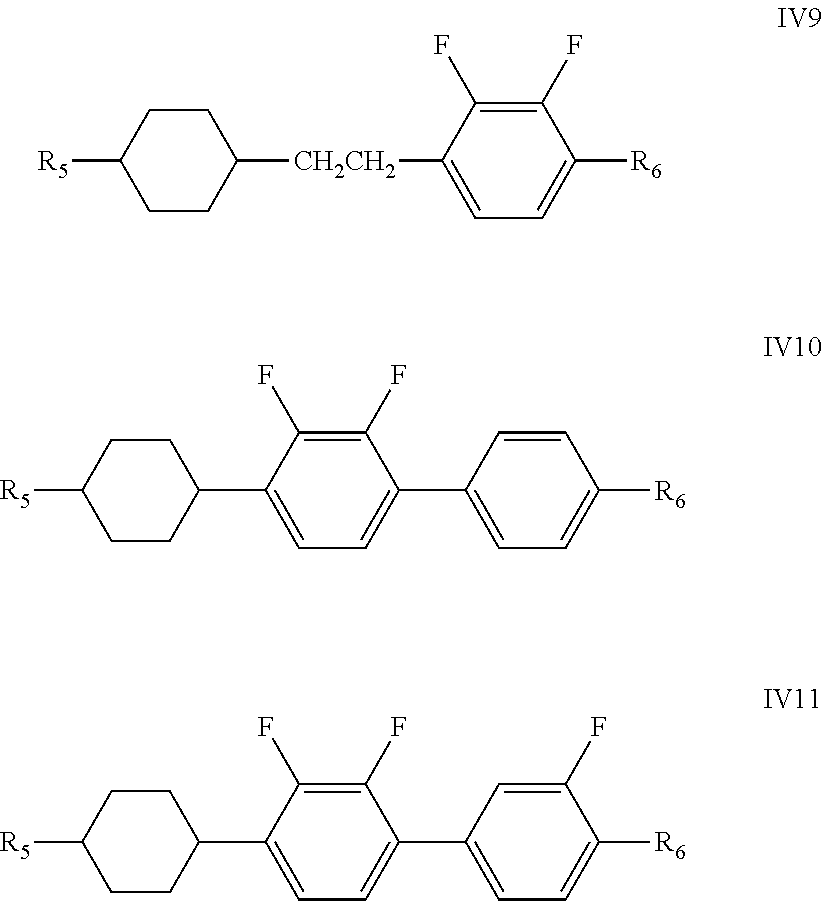








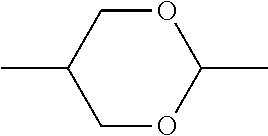
















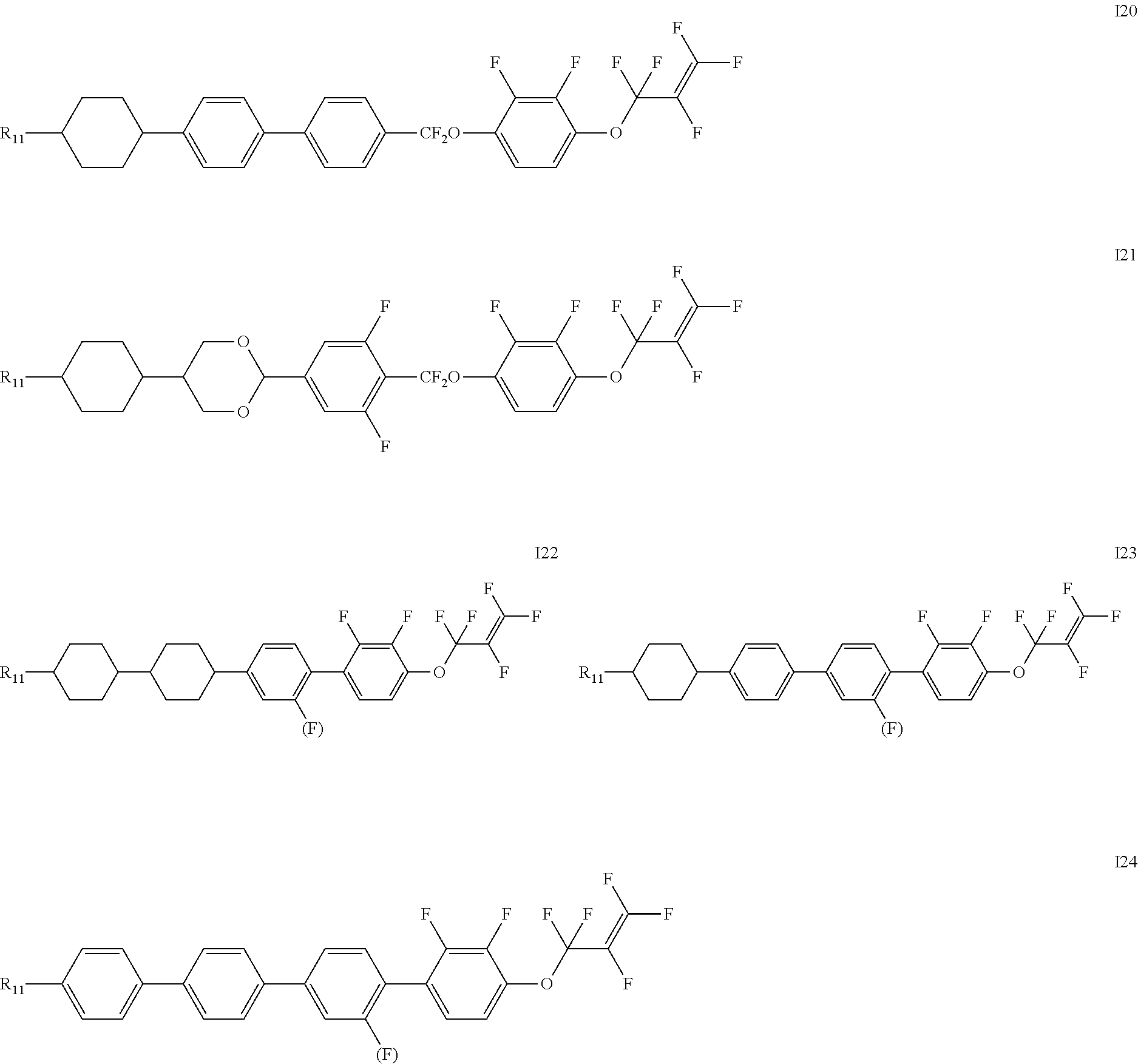
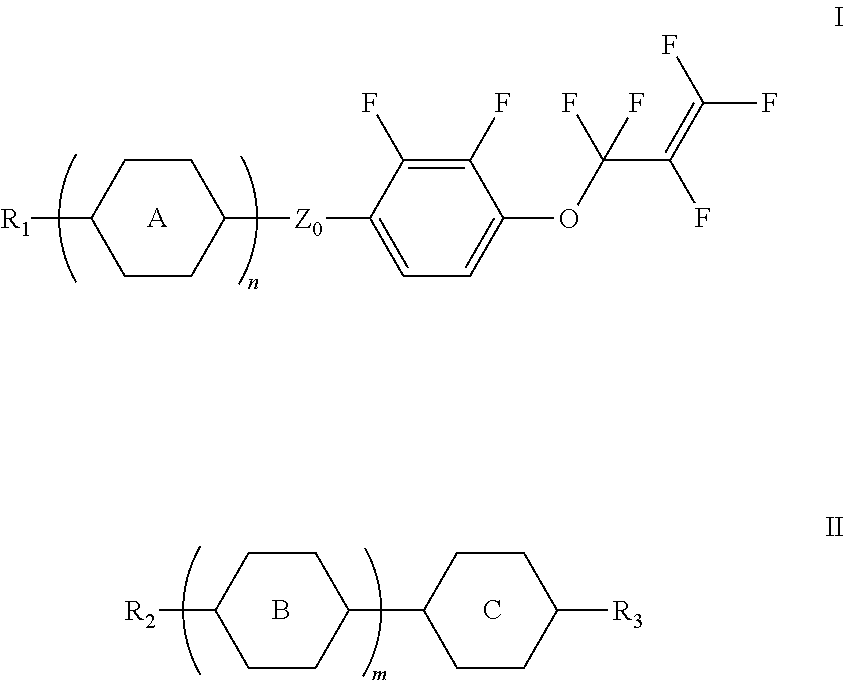












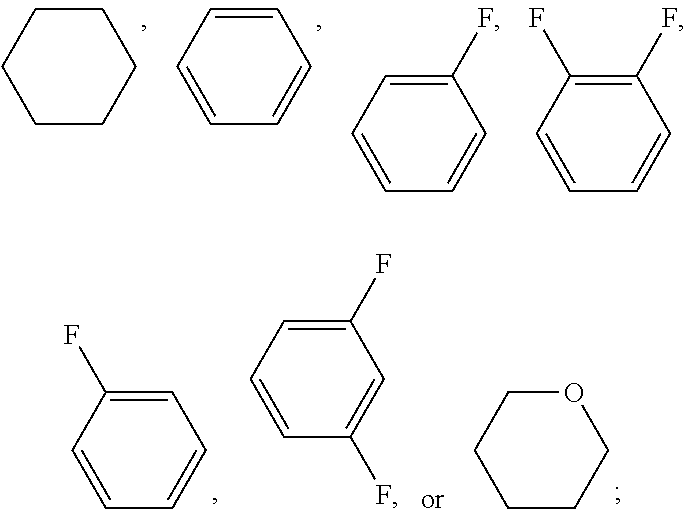


XML
uspto.report is an independent third-party trademark research tool that is not affiliated, endorsed, or sponsored by the United States Patent and Trademark Office (USPTO) or any other governmental organization. The information provided by uspto.report is based on publicly available data at the time of writing and is intended for informational purposes only.
While we strive to provide accurate and up-to-date information, we do not guarantee the accuracy, completeness, reliability, or suitability of the information displayed on this site. The use of this site is at your own risk. Any reliance you place on such information is therefore strictly at your own risk.
All official trademark data, including owner information, should be verified by visiting the official USPTO website at www.uspto.gov. This site is not intended to replace professional legal advice and should not be used as a substitute for consulting with a legal professional who is knowledgeable about trademark law.